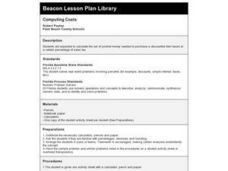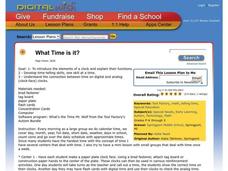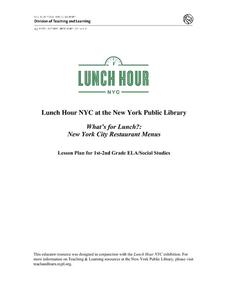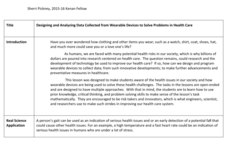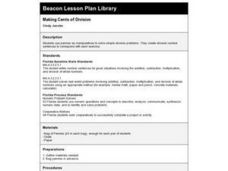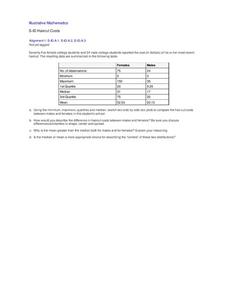Curated OER
Computing Costs
Seventh graders calculate the out-of-pocket money needed to purchase a discounted item taxed at a certain percentage of sales tax.
Curated OER
Seeing Numbers In Tens And Ones
Second graders develop the skill of place values up to the tens place. They practice identifying the values of 2 digit numbers and writing the correlating values with counting. They use the example of money to make the lesson more...
Curated OER
Let's Try Various Calculations
Young scholars explore math facts. In this calculation and math facts lesson, students play a board game in which addition, subtraction, multiplication, and division math facts are practiced. A copy of the game is included.
Curated OER
What Time is it?
Pupils participate in three centers focused on developing time-telling skills. In this time instructional activity, students create their own paper plate clock face, play "Time Concentration" using times on the hour and half hour, as...
Curated OER
Economics and emissions
Eighth graders produce a manufactured good and monitor energy consumption. In this Math instructional activity, 8th graders practice their basic math and accounting skills. Students participate in a business simulation.
Curated OER
Whole Number Game Time
First graders play math games to develop a better understanding of whole numbers. They represent and use whole numbers up to 100. They estimate how many times they would have to roll two dice before they would get to 100 and record...
Curated OER
Ratio and Proportion: Basic Operations and Applications
Learners explore example problems dealing with ratios and proportions. Afterward, they read story problems and solve them using ratios and proportions. This four-page worksheet contains six multi-step problems.
Curated OER
Investment Problems
In this investment problem worksheet, students read story problems and use the interest formula to determine the total amount invested, or rate of return. This one-page worksheet contains six problems, with answers.
Curated OER
Probability or Ability?
Pupils use their non-dominant hand to catch candy which they tossed in the air. They estimate how many they catch in a second round. They record and determine how the probability changed the second time.
Curated OER
Time Flies When Math Is Fun
Third graders pracdtice telling time with a demonstration clock.
Curated OER
Avoiding Consumer Fraud: Financial Scams and Schemes
Young consumers get a hefty dose of information on how fraud can put their financial health at risk. The resource provides detailed lecture notes, scaffolded notetaking sheets, vocabulary worksheets, transparencies, and seven links to...
Illustrative Mathematics
Seven Circles III
A basic set-up leads to a surprisingly complex analysis in this variation on the question of surrounding a central circle with a ring of touching circles. Useful for putting trigonometric functions in a physical context, as well as...
New York Public Library
What's for Lunch?: New York City Restaurant Menus
Do you remember the days when a cup of coffee cost five cents? At A.W. Dennett restaurant in 1894, you could buy a five-cent cup of coffee and as well as a five-cent slice of pie to accompany it. The menu from that year is a primary...
Kenan Fellows
Designing and Analyzing Data Collected from Wearable Devices to Solve Problems in Health Care
Wearable devices have become more the norm than the exception. Learners analyze data from a sample device with a regression analysis in a helpful hands-on lesson. Their focus is to determine if there is a connection between temperature...
Curated OER
The Price is Right, So Let's Make Change
Young scholars estimate, calculate, and count back the amount of change needed from purchases made during small group activities.
Curated OER
Needs and Wants
Students examine the difference between psychological needs and wants to control spending.
Curated OER
Making Cents of Division
Third graders use pennies as manipulatives to solve simple division problems. They create division number sentences to correspond with each exercise. This is a good, hands-on way to teach the concept of division.
Curated OER
Variations on a Human Face Lab
Ninth graders gain an application level understanding of probability, symmetry, and ratios and rates that exists in one's everyday environment relative to human genetics.
Curated OER
Interest and Credit
Students define interest and credit. In this algebra lesson, students analyze the pros and cons of having credit versus debit and interest as it applies to credit and debit. Students apply the ideas of interest and credit in their...
Curated OER
Graphing
Students collect data and graph their results, then analyze the graphs. In this geometry lesson, students examine slopes and their graphs and discuss the relationship between the lines and the slopes.
Curated OER
Barter and Trade
Students explore the concepts of bartering and trading. In this algebra lesson, students barter with each other for different items. They use special cards to designate ownership of an item as they explore the complexity of bartering.
Illustrative Mathematics
Haircut Costs
Who pays more for haircuts, men or women? Given quartile values, learners construct box and whiskers plots and interpret the results. They compare the mean and median, and discuss which is more appropriate under particular conditions....
Curated OER
Pacing a Gunther Chain
Students pace a Gunther Chain, a measurement used by foresters to determine distance and area. They discuss that pacing is individualized depending on age, gender, etc. They practice to find an average pace. Teams estimate, pace and...
Curated OER
Financial Contracts
Prepare your class for the real world and learn the basics about credit and the principles behind using it wisely. The activity includes handouts that explain the necessary vocabulary and concepts to understanding credit. After reviewing...


